Colorado II (Armored Cruiser No. 7)
1905–1930
The second U.S. Navy ship named for the 38th State, admitted to the Union on 1 August 1876.
II
(Armored Cruiser No. 7: displacement 13,780; length 504'; beam 69'6"; draft 24'1"; speed 22 knots; complement 825; armament 4 8-inch, 14 6-inch, 18 3-inch, 2 18-inch torpedo tubes; class Pennsylvania)
The second Colorado was launched on 25 April 1903 by William Cramp and Sons Ship and Engine Building Co., Philadelphia, Pa.; sponsored by Miss. Cora M. Peabody, daughter of Governor James H. Peabody of Colorado; and commissioned on 19 January 1905, Capt. Duncan Kennedy in command.
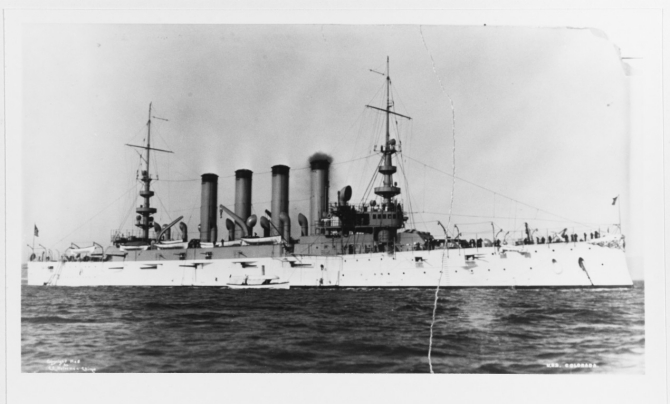
Colorado sailed on her shakedown cruise down the east coast to Target Bay, Culebra Island, P.R., and trained in Caribbean waters (12 March–9 May 1905 — she reached Culebra on 24 March). Following the shakedown, she joined Division Four, Cruiser Squadron, Atlantic Fleet, at Provincetown, Mass., on 14 May. Colorado took part in the preliminary test of Dewey steel floating drydock near Solomons Island, Md. (23–24 June 1905). A coal bag knocked Seaman Frederick Newman overboard, killing him, on 27 June 1905.
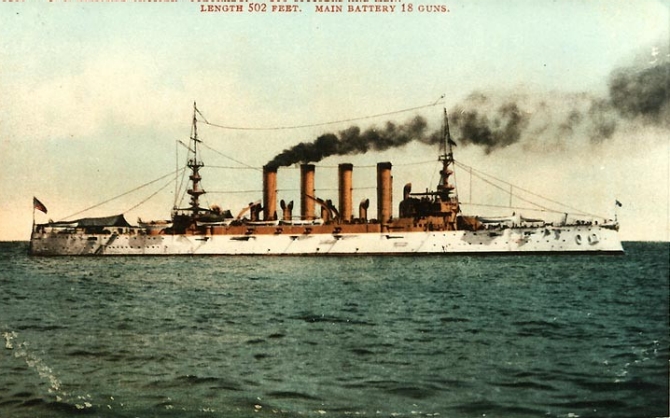
President Theodore Roosevelt mediated the signature of the Treaty of Portsmouth, which ended the Russo-Japanese War, at Portsmouth Navy Yard, N.H., on 5 September 1905. Colorado sailed as one of the ships that escorted President Roosevelt on his triumphal return to Washington, D.C. The ship met the chief executive at Newport, R.I. (14–16 October). She then reached Key West, Fla., where she escorted him to the Potomac River (20–28 October). Colorado rejoined Division Four off Cedar Point Light, Chesapeake Bay, on Halloween.
British Adm. Prince Louis Alexander of Battenberg, who broke his flag in armored cruiser Drake, led five other armored cruisers of the Royal Navy’s Atlantic Fleet, Second Cruiser Squadron -- Bedford, Berwick, Cornwall, Cumberland, and Essex -- on a goodwill voyage along the east coast. Colorado sailed as one of the ships that welcomed the Prince during his visit to the Naval Academy at Annapolis, Md. (1–7 November 1905). Colorado participated in a fleet problem in the Caribbean (10 January–17 April 1906). Capt. Kennedy died while the armored cruiser maneuvered at sea. He was buried ashore at Guantánamo Bay, Cuba, and Lt. Cmdr. Joseph L. Jayne assumed command of the ship on 12 April 1906.
Rear Adm. Paul Campion led a French squadron, consisting of armored cruisers Amiral Aube, Condé, and Marseillaise, that visited Annapolis in the ceremony commemorating the exhumation of John Paul Jones from his original grave in Paris, France, for interment at the Naval Academy. Colorado took part as one of the ships that greeted the French when they visited Tompkinsville, N.Y., before they returned to French waters (22–26 April).
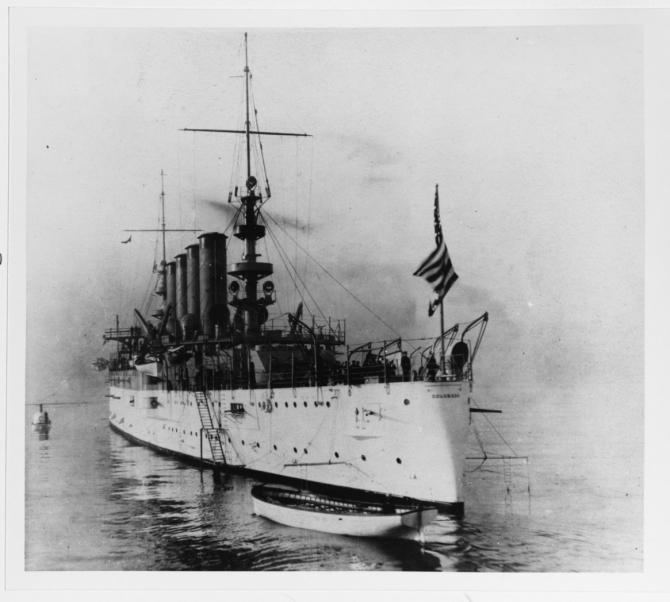
President Roosevelt held a Presidential Naval Review of a number of ships including Colorado, Florida (Monitor No. 9), Indiana (Battleship No. 1), Truxtun (Torpedo Boat Destroyer No. 14), and transport Yankee at Oyster Bay, N.Y. (2–4 September 1906). Colorado then sailed for duty on the Asiatic Station (7 September). The ship stopped briefly in Honolulu in the Hawaiian Islands and at Guam, reaching Cavite Island in the Philippines on 18 November 1906. She cruised in connection with American interests in Chinese and Japanese waters during the succeeding months, and then carried out tactical maneuvers off Corregidor Island, Philippines (2–19 August 1907). Colorado visited Yokohama, Japan, from where she came about for home on 22 August. She visited Honolulu (2–19 September), and returned to San Francisco on 27 September 1907.
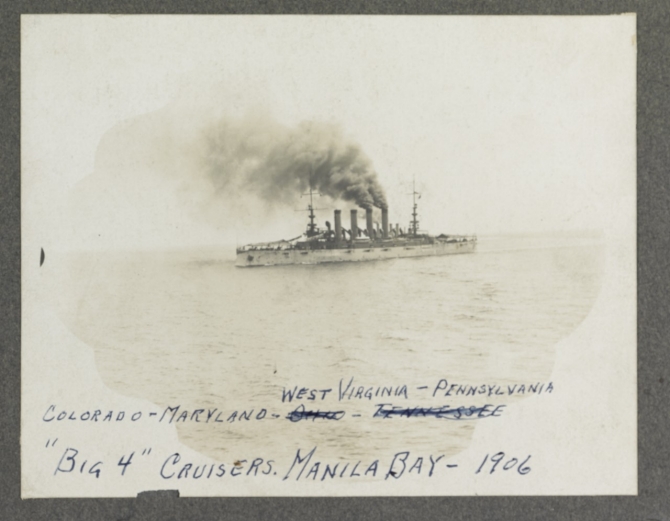
Rear Adm. William T. Swinburne, Commander-in-Chief of the Pacific Fleet, inspected the ship at Santa Barbara, Calif. (12–18 October). Colorado then operated on maneuvers with the 1st Division along the Californian coast, followed by additional training in Magdalena Bay, Mexico (31 December 1907–15 February 1908). She accomplished repairs at Puget Sound Navy Yard, Bremerton, Wash. (23 February–1 May).
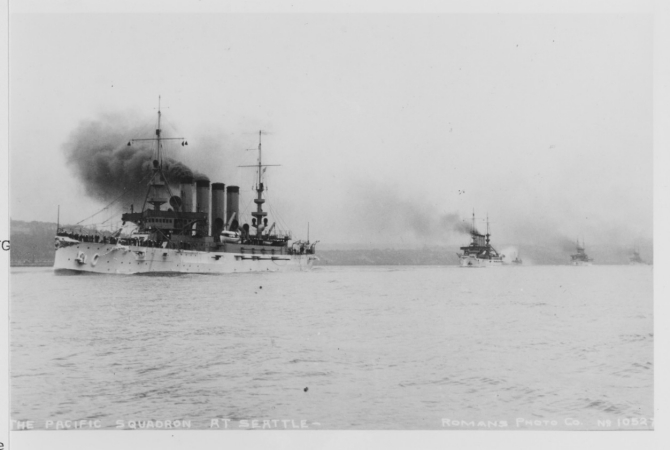
Secretary of the Navy Victor H. Metcalf reviewed Colorado at San Francisco (6–19 May 1908). The ship ran aground at Lip Lip Point, Wash., on 15 August, and completed repairs at Puget Sound (15 August–24 September). The state of Colorado presented the ship with a sterling silver service while she lay at San Francisco on 2 October. Colorado cruised in fleet maneuvers in Hawaiian waters (12–22 October 1908). She sailed with the Pacific Fleet in South American waters, and protected Americans during political disturbances in Amapala, Honduras (early 1909), returning home on 19 May 1909. The ship participated in the Alaska-Yukon-Pacific Exposition at Seattle, Wash. (3–10 June). She then carried out repairs and maintenance at Puget Sound (10 June–29 August).
Colorado sailed again for the Far East (10 September 1909–14 February 1910). Her voyage carried her through Hawaiian and Philippine waters. A boiler tube blew out, killing Ordinary Seaman Leo M. Lipetzky and Coal Passer Charles P. McDermott, on 9 September 1909. The armored cruiser visited Honolulu (10 September–5 October), carried out target practice and divisional battle training off Cavite on 4 November, and then sailed in Chinese waters. Colorado visited Yokohama (17–20 January 1910). The ship visited Honolulu, and returned to the United States on 8 February. She underwent an overhaul at Puget Sound (7 April–9 August). She next visited Valparaiso to take part in the Chilean Centennial, commemorating the 100th anniversary of the independence of Chile (14 August–16 October 1910 – she stayed at Valparaiso 10–28 September). The Japanese training squadron, consisting of cruisers Aso and Sōya (formerly Russian Bayern and Varyag, respectively, captured by the Japanese during the Russo-Japanese War), meanwhile sailed along the U.S. and Canadian west coast. Colorado returned from Chilean waters in time to greet the Japanese off California (21–30 November). She completed an overhaul at Puget Sound (7 January–3 June 1911).
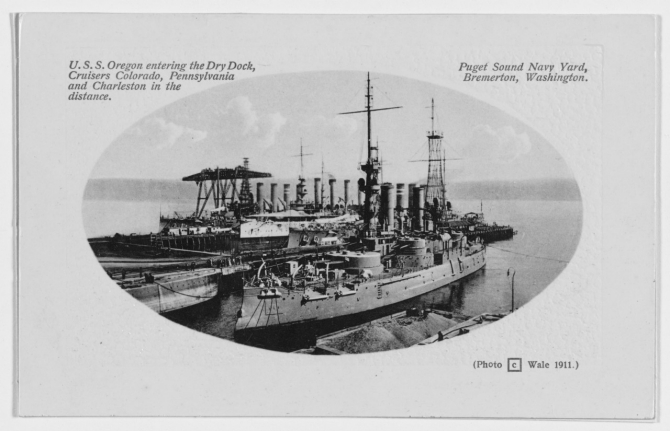
The ship took part in Golden Potlach, an annual festival that celebrated the heritage and development of Seattle (17–21 July 1911). This particular festival, the first of the series, highlighted the Klondike Gold Rush of the 1890s. She then participated in the reception to welcome Japanese Adm. Tōgō Heihachirō during his tour of the United States (17 July–29 August 1911 — she welcomed the admiral 27–29 August). Colorado returned to San Francisco for a reception of President William H. Taft (10–17 October). She next took part in a review of the Fleet at San Pedro, Calif. (1–4 November).
Ceremonial visits and receptions for dignitaries highlighted the next two years, and Colorado returned to Hawaiian and Philippine waters (21 November 1911–11 July 1912). Her stop at the Hawaiian Islands included a visit to Hilo, where many men went ashore to view Kilauea Volcano. Colorado conducted target practice drills while in the Philippines (8 April–10 June 1912). She then completed an availability at Puget Sound (11 July–25 August). The ship sailed to land and support expeditionary troops during disturbances at Corinto in Nicaragua (25 August–22 November). Early in the New Year (14 February–7 April 1913) she patrolled Mexican waters with South Dakota (Armored Cruiser No. 9) to protect Americans threatened by the Mexican Revolution. Colorado assisted Maryland (Armored Cruiser No. 8) during target practice, and as a target for submarines, at San Diego on 5 May. She was placed in reduced commission as part of the Pacific Reserve Fleet at Puget Sound Navy Yard (17 May 1913–9 February 1915). The ship was placed in reserve with the Pacific Reserve Fleet at Puget Sound on 28 May.
Once more in full commission on 9 February 1915, she sailed as the flagship of the Pacific Reserve Fleet, patrolling in Mexican waters and observing and keeping in touch with interned merchant ships during the Mexican Revolution (20 June–19 August 1916), and then returned to reserve status on to 26 September. An engine room fire burned Machinist’s Mate 1st class Saul Torgerson, who died the next day in San Francisco (24–25 September). The following day the ship returned to reserve status, and meanwhile completed an overhaul (29 September–2 December 1916).
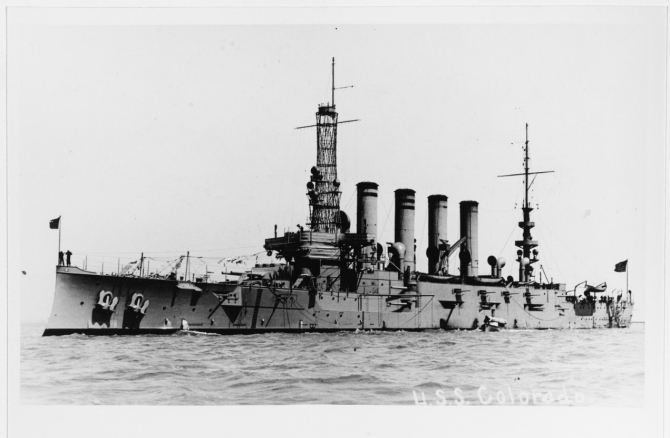
Colorado was renamed Pueblo on 9 November 1916 while in overhaul (29 September–2 December 1916) to free up the name for new battleship Colorado (Battleship No. 45—redesignated BB 45 on 17 June 1920). Submarine H‑3 ran aground in Humboldt Bay, Calif., on 14 December 1916. Milwaukee (Cruiser No. 21) sailed for Eureka, Calif., to assist in salvaging the boat on 5 January 1917. While she attempted to float the submarine on 13 January, the cruiser stranded in the first line of breakers at Samoa Beach off Eureka. Her crewmen reached shore safely. Pueblo made for the area and stood by Milwaukee on 24 January, but attempts to salvage the stricken cruiser proved unsuccessful. Milwaukee was decommissioned on 6 March 1917, and a storm in November 1918 broke the ship in two.
Following a yard period Pueblo returned to Pichilingue Bay, Mexico, on 30 March, to blockade interned German ships. Rumors indicated that German ships interned at Santa Rosalia, Mexico, intended to escape in the event that the United States entered WWI, and Pueblo put into that port to investigate the rumors on 2 April 1917. Four days later, the U.S. declared war on the Germans, and the ship made all preparations to meet the enemy. Messages circulated that German U-boats and commerce raiders ranged the seas, and Pueblo received orders to “be on the alert for them.” She returned to San Diego and joined the Scouting Force, Pacific Fleet, on 2 May 1917. The ships of the force hurriedly made their preparations and sailed on 12 May, under the command of Adm. William B. Caperton, Commander in Chief, Pacific Fleet, via the Panama Canal for the Caribbean and South Atlantic. Frederick (Armored Cruiser No. 8), Pittsburgh (Armored Cruiser No. 4), and Pueblo reached Balboa, Panama Canal Zone, on 16 May. They passed through the canal, steamed from Colón on 29 May, and held drills, exercises, and sub-caliber practice while proceeding to the South Atlantic for patrol duty from Brazilian ports. They arrived off Bahia, Brazil, on 14 June. The squadron was to prevent German and Austro-Hungarian ships interned at Bahia from escaping into the Atlantic to operate as blockade runners or commerce raiders.
Pittsburgh, Pueblo, and South Dakota sailed from Bahia on 20 June 1917, reaching Rio de Janeiro two days later. The ships called on the port to celebrate U.S. Independence Day, and held full dress on 4 July. Brazilian President Venceslau Brás (Pereira Gomes) visited Pittsburgh at 1300, and fifteen minutes later, South Dakota landed the ships battalion to parade as infantry through the streets of the city. British, French, and Brazilian forces also landed and took part in the festivities. South Dakota recorded that the large crowds of onlookers displayed “great enthusiasm” during the celebration. Frederick -- which had reached Rio de Janeiro in the interim -- Pittsburgh, Pueblo, and South Dakota sailed on 6 July 1917, four days later arriving at Montevideo, Uruguay. The squadron steamed from Uruguayan waters on 23 July. The following day, a composite Argentinean division of three cruisers and four torpedo boats met the U.S. ships and escorted them into Buenos Aires. The Americans recorded that “several hundred thousand” Argentineans provided a “very cordial” welcome during multiple excursions, dinners, and theater parties. The ships sailed from Buenos Aires on 1 August, called on Montevideo, and returned to Rio de Janeiro on 6 August.
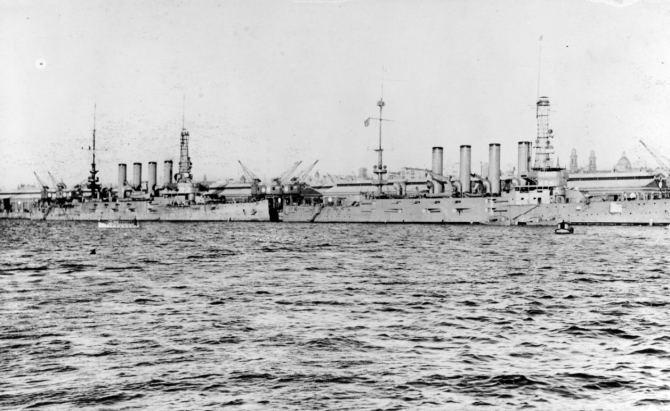
Frederick and South Dakota stood out of Rio de Janeiro and proceeded toward Bahia on 9 August 1917. The ships sailed in accordance with Campaign Order No. 1, designating them as the Northern Patrol Force. These orders directed the two armored cruisers to alternate their patrols to capture or sink enemy vessels north of Bahia as far as Ilha Fernando de Noronha and east to 20° W. One of the vessels was to steam at sea for a patrol of 14 days, cruising at ten knots during daylight and five knots at nighttime. The other cruiser was to remain at Todos os Santos, a bay at Bahia, overhauling during the first seven days, and then standing by for the second seven days. Pittsburgh and Pueblo patrolled from Rio de Janeiro eastward to cover the trade lanes between that city and Bahia.
The first 24 hours inaugurated the patrols with a dramatic confrontation. German commerce raider Seadler wreaked havoc with Allied shipping during this period. Formerly U.S. full-rigged ship Pass-of-Balmaha, she proved successful as a raider in large measure because of her sailing rig, which repeatedly enabled Seadler to surprise her victims. The raider prowled in South American waters prior to the arrival of South Dakota but then temporarily disappeared from Allied intelligence. While proceeding toward Bahia on 10 August 1917, South Dakota sighted a full rigged ship on the starboard bow. The vessel resembled descriptions of Seadler, and the cruiser intercepted the suspected raider. A boarding party inspected the ship but discovered Norwegian vessel Sandpigen, bound with a load of coal from Philadelphia, Pa., to Santos, Brazil. Seadler meanwhile rounded Cape Horn in April 1917, and hunted her prey in the Pacific. She anchored at Mopeha in the Society Islands on 31 July, but wrecked on a reef there on 2 August.
Pueblo reported that during her patrols she “boarded and examined all ships sighted; to all Allied captains gave latest orders re routes to be taken.” On 14 October, Frederick, Pittsburgh, Pueblo, and South Dakota set out from Rio de Janeiro. The ships accomplished battle practice and maneuvers en route to Montevideo, arriving on 18 October. South Dakota received orders detaching her from duty with the Pacific Fleet and directing her to rendezvous with Division Two, Cruiser Force Atlantic Fleet, at New York, on 2 November 1917. Prior to her departure, the ship received drafts of men from Frederick, Glacier, Pittsburgh, and Pueblo for transfer to the U.S.
Pueblo reached Colón on 11 January, and completed repairs and overhaul in drydock at Norfolk Navy Yard (18 January–5 February 1918). She then sailed for New York, reaching Tompkinsville on 5 February, and helped escort a troop convoy to European waters, turning her charges over to the Eastern Escort and returning to Hampton Roads, Va. (10 February–5 March). She made six more voyages to escort convoys carrying men and supplies to England. Generally speaking, the larger and faster cruisers of Cruiser Squadron One escorted troop convoys, while the smaller vessels of Cruiser Squadron Two escorted cargo convoys. Frederick, Pueblo, San Diego (Armored Cruiser No. 6), and South Dakota initially comprised Division Two of Cruiser Squadron One. During her brief intervals between these convoys, Pueblo engaged in battle practice off Hampton Roads.

Secretary of the Navy Josephus Daniels ordered Pueblo to detach from her seventh convoy on 14 October. The ship came about for Tompkinsville, where she embarked Brazilian Ambassador Domicio da Gama to the United States and two members of his staff on 22 October, and returned them via St. Thomas, Virgin Islands (27–28 October), to Rio de Janeiro (9–12 November). She returned to Hampton Roads on 28 November. Pueblo completed an overhaul at New York Navy Yard. Pueblo returned to transatlantic duty as part of the Cruiser and Transport Force, making six voyages between Hoboken and Brest, France, to bring 10,237 veterans of the American Expeditionary Force home (23 December 1918–16 July 1919. Two days later, she detached from the Cruiser and Transport Force and returned to the Fleet.
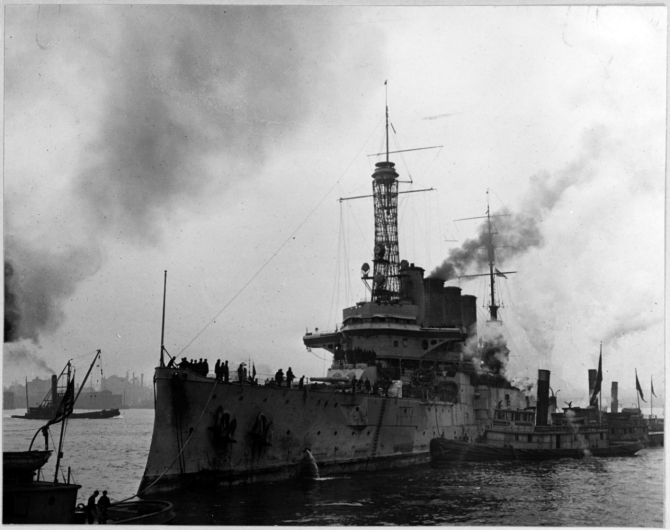
Pueblo completed an availability at Norfolk Navy Yard. She was placed in reduced commission at Reserve Basin, Philadelphia Navy Yard, on 8 August 1919. Pueblo was decommissioned at Philadelphia on 22 September 1919.
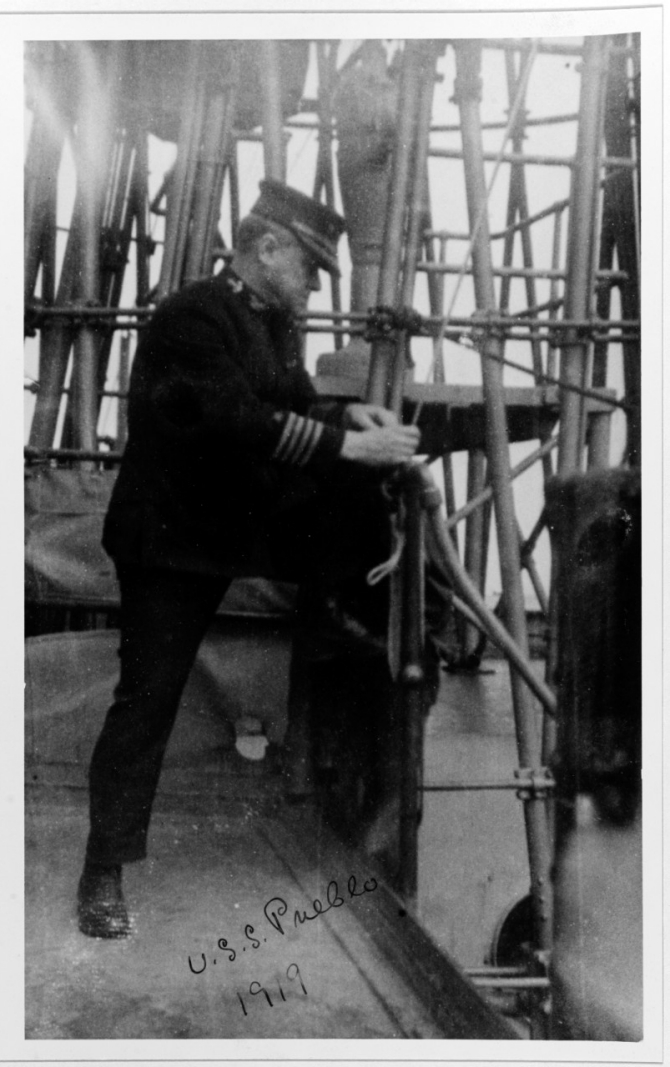
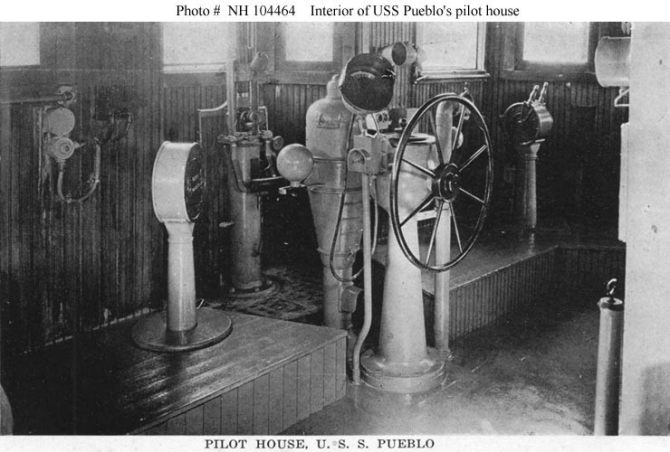
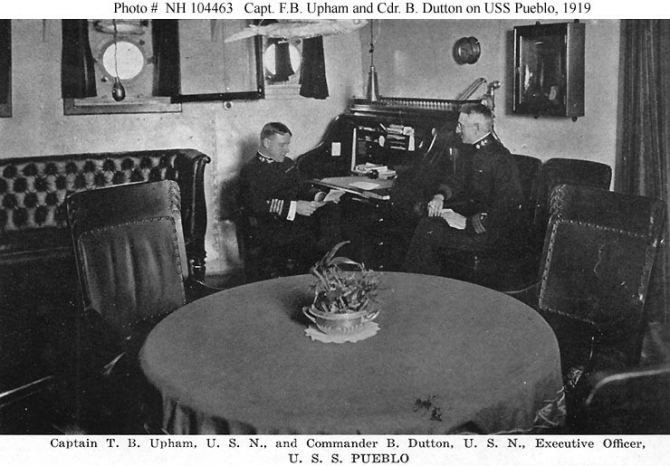
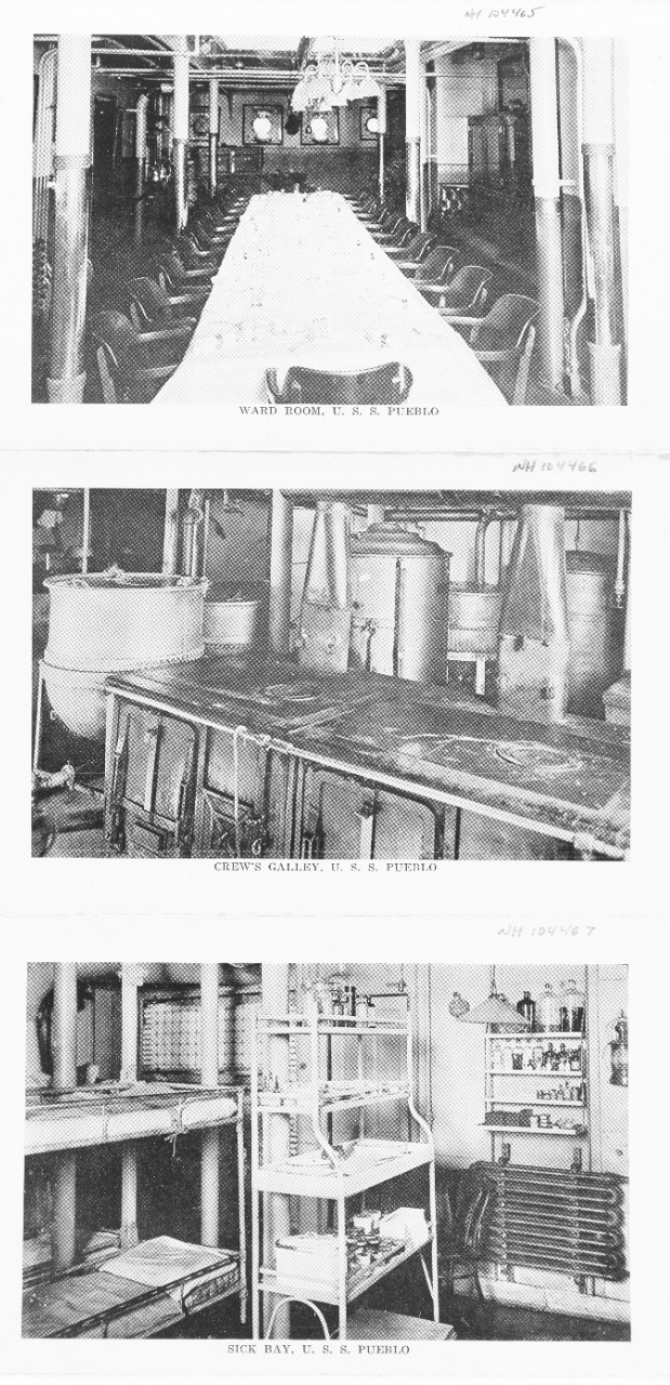
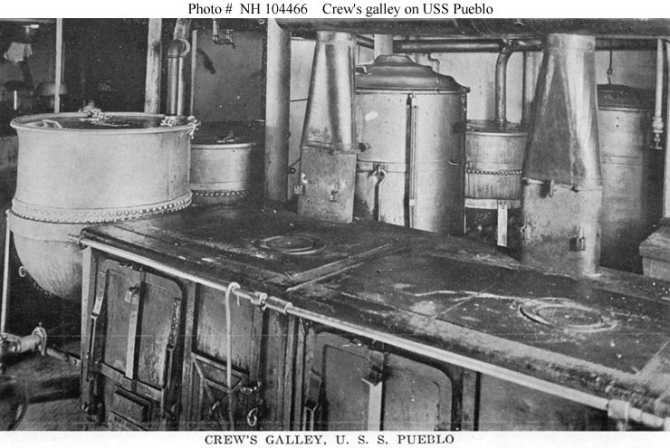
In commission for the last time, Pueblo served as receiving ship in the 3rd Naval District at New York, on 2 April 1921. Heavy cruiser Seattle (CA-11) relieved Pueblo as receiving ship, and Pueblo was decommissioned on 28 September 1927. Two days later, Pueblo was towed to the Philadelphia Navy Yard. She was stricken from the Navy on 21 February 1930, and scrapped on 2 October 1930, her parts sold to various metal companies.
Commanding Officer Date Assumed Command
Capt. Duncan Kennedy 19 January 1905
Lt. Cmdr. Joseph L. Jayne 12 April 1906
Capt. Sydney A. Staunton 16 July 1906
Capt. Edmund B. Underwood 28 February 1908
Lt. Cmdr. Glennie Tarbox 7 October 1908
Capt. Charles B.T. Moore 29 December 1908
Lt. Cmdr. Bion B. Bierer 26 November 1909
Capt. Valentine S. Nelson 23 December 1909
Capt. William A. Gill 12 August 1910
Cmdr. Eugene L. Bisset 24 December 1912
Capt. William W. Gilmer 6 January 1913
Cmdr. Charles J. Lang 22 May 1915
Capt. Ashley H. Robertson 1915
Cmdr. Martin L. Trench 1916
Capt. George W. Williams 29 April 1917
Capt. Frank B. Upham 6 September 1917
Cmdr. Benjamin Dutton 19 July 1919
Capt. Orin G. Murfin 9 September 1919
Mark L. Evans
12 October 2016


